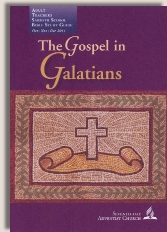|
||||||||||||||
Commentary on "The Two Covenants"
Day 1: Sabbath Afternoon, November 26, 2011 - Introduction
Overview
This week’s lesson covers Galatians 4:21-31 and attempts to deal with Paul’s exposition on the relationship between the Old Covenant and the New Covenant. The general thrust of the teaching can be summed up by this excerpt, “The two covenants are not matters of time; instead they are reflective of human attitudes....The old covenant represents those who...mistakenly rely on their own obedience as a means of pleasing God; in contrast, the new covenant represents the experience of those who...rely wholly upon God’s grace to do all that He has promised.”
Observations
The author is faced with a difficult challenge. In this passage, Paul clearly links the Old Testament law to the Old Covenant proceeding from Sinai, portrays the Old Covenant in a negative light, and calls for it to be cast out. As an Adventist, the author must preserve certain aspects of the Old Testament law and the covenant it is tied to, especially the Sabbath, while dealing with Paul’s renunciation of the Old Covenant and negative comments about those who want to be under the law. He sets the stage for this feat by putting forth a straw man argument.
The author infers that it is common for non-Adventist Christians to reject the authority of the Old Testament, believe that there was a time in history when salvation was based on obedience, and claim that grace is something specific to the New Covenant. This is simply incorrect on all counts. While it seems likely that one could find these aberrant views espoused by some individuals or groups at various points in history, they certainly do not represent historic, orthodox Christian thought down through the ages. These views are neither representative of orthodoxy or common within Christianity.
First, let us deal with the claim that many Christians reject the authority of the Old Testament. Orthodox Christians have always believed that, “All Scripture is inspired by God and profitable for teaching, for reproof, for correction, for training in righteousness” (2 Timothy 3:16 NASB). This includes both the Old and New Testaments. Orthodox Christians also believe that Jesus is the ultimate revelation of God. The teachings of Jesus and his apostles made things plain that were mysteries in the Old Testament or that were only partially known. This does not mean that the New Testament corrects the Old Testament, only that it provides more information that expands and clarifies many things that were not fully known in the Old Testament. So orthodox Christians allow the New Testament to shed light on the Old Testament and interpret the Old Testament in the full light of scripture.
While the entire Bible is for our instruction, not every command is directly to us. So, when an orthodox Christian comes across an Old Testament command requiring animal sacrifices, they would not immediately jump to the conclusion that New Covenant Christians are required to offer animal sacrifices. Rather they would ask several questions, such as, “Who was this command to? Why was it given? What did it mean to the original hearers? What light does the full Bible, including the New Testament, shed on this command? In the light of the full Bible, what does this mean to me as a New Covenant Christian?” When these questions are faithfully and systematically applied, one comes to the conclusion that animal sacrifices were a shadow pointing to the work of Christ, the command has been fulfilled in Him, we rest in his finished work as the lamb of God, and this is no longer an issue of obedience for New Covenant Christians. Such a conclusion in no way nullifies the authority of the Old Testament, rather it establishes it. We are able to see why such shadows were implemented, what they pointed to, and how they were completely fulfilled in Christ. This understanding informs us in our knowledge of Jesus’ work and in our place in Him. Similar things could be said about other Old Testament laws that that the New Testament calls shadows such as food laws, annual feast Sabbaths, New Moon Sabbaths, and the weekly Sabbath day (see Col. 2:8-20).
Finally, the inference that many Christians believe there was a period of time when salvation was based on keeping the law is wrong on its face. The author offers no proof that this is a common belief and it certainly flies in the face of two thousand years of Christian thought. While there are some differences in how we are called to outwardly demonstrate obedience between the Old and New Covenants, these are not the basis of salvation. Orthodox Christians believe that all people of all times have always been saved in the same way: by grace alone, through faith alone, in the Messiah alone. It is possible that the author misunderstands the orthodox view of the purpose of the law. Christians believe that the Old Covenant law was added until the Messiah would come so that our sinfulness, condemnation, and need for a savior Messiah would be clear. Before the Messiah came, the law was a tutor to lead us to Him. Now that Jesus has come we are no longer under a tutor because we have become sons of God and are clothed in Christ Jesus (see Gal. 3:15-29).
Finally, it should be noted that the orthodox beliefs and Bible passages referenced above support the concept that the Old Covenant and its law were, in fact, time specific. While the author is in a sense correct that the covenants reflect human attitudes about how we may have peace with God, he is incorrect in suggesting that the Old Covenant was not time specific. The weight of biblical evidence is against his assertion. The Old Covenant law was put in place to condemn us and drive us to Christ. Now, because of Jesus’ finished work our sins are remembered no more. When Jesus said He was making "a new covenant," He made the first obsolete and caused it to grow old and disappear (Heb. 8:12-13 NASB). The Bible could not be more clear that the Old Covenant was time specific.
Summary
- In contradiction to the authors assertion, Christians do accept the authority of the Old Testament, but this does not mean that every command in the Old Testament is a command to New Covenant Christians (animal sacrifices are a quintessential example).
- In contradiction to the authors assertion, Christians believe that all people of all times were saved in the same way, by grace alone, through faith alone, in the Messiah alone.
- Christians believe that the Old Covenant law was added, until the Messiah would come, as a tutor to lead us to Him. Now that Jesus has come we are no longer under a tutor.
- The Old Covenant and its law were time specific.The Old Covenant has been made obsolete by the New Covenant.
Copyright 2011 BibleStudiesForAdventists.com. All rights reserved. Revised November 6, 2011. This website is published by Life Assurance Ministries, Glendale, Arizona, USA, the publisher of Proclamation! Magazine. Contact email: BibleStudiesForAdventists@gmail.com.
The Sabbath School Bible Study Guide and the corresponding E.G. White Notes are published by Pacific Press Publishing Association, which is owned and operated by the Seventh-day Adventist church. The current quarter's editions are pictured above.
Official Adventist Resources
Standard Edition Study Guide Week 10
Teacher's Edition Study Guide Week 10
Easy Reading Edition Study Guide Wk 10
Search the Complete Published Ellen G. White Writings
Please Support This Project


